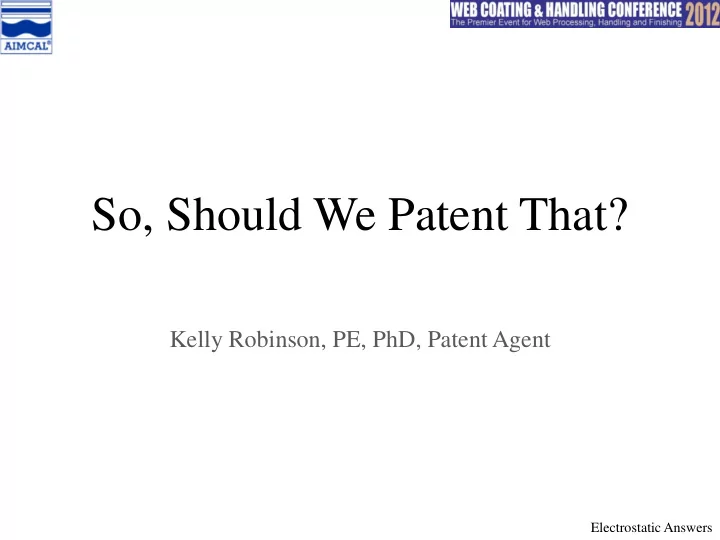

So, Should We Patent That? Kelly Robinson, PE, PhD, Patent Agent Electrostatic Answers
Agenda 1. Motivation a. Technical advances enable new products and improve operations. b. Protecting our ideas and advances is important. c. How do we decide what Intellectual Property path is best? 2. Intellectual Property Options a. File a patent. b. Maintain the invention as a Trade Secret. c. Disclose the invention. Why?! d. Do nothing and get on with other high priority work. 3. Summary a. Consider uniqueness and detectability. b. A patent is an offensive right. c. Maintaining a trade secret requires diligent effort. d. A disclosure is a defensive strategy. 2 / 15
Motivation Technical advances enable new products and improve operations. How do we decide what intellectual property path is best? 3 / 15
IP Options Easy to see (product feature) Detectability Default: PATENTS DO NOTHING DISCLOSE Many Only possible one alternatives alternative Uniqueness TRADE SECRETS Hard to see (process set-point) Uniqueness and detectability help determine the best intellectual property option. 4 / 15
What is a Patent? A patent is a contract between an inventor and the U.S. government under which the government grants the inventor a limited monopoly. In return for these patent rights, the inventor discloses the complete invention to the public to promote the progress of science. 5 / 15
What is a Patent? A patent is an “offensive” right in the sense that the holder of a patent has the right to exclude others from making, using, or selling a claimed invention (sue for patent infringement). 6 / 15
Trade Secret Easy to see (product feature) Detectability Default: PATENTS DO NOTHING DISCLOSE Many Only possible one alternatives alternative Uniqueness TRADE SECRETS Hard to see (process set-point) When an invention is unique and difficult to detect, maintain it as a trade secret. 7 / 15
What is a Trade Secret? A “Trade Secret” is confidential information that provides an economic advantage. 8 / 15
Protect Trade Secrets Table 2: Layers of security to maintain Trade Secrets D OCUMENT 1. Document trade secrets in internal reports. 2. Maintain a list of trade secret technologies. 3. Label documents as “confidential.” 4. Keep confidential documents in lock file cabinets or in encrypted files. L IMIT A CCESS 5. Limit access to facilities (fence, secure doors, etc.). 6. Limit access to trade secret technology on a “need to know” basis. A DMINISTRATIVE A CTIONS 7. Require all employees to keep confidential information secret (employee agreement). 8. Require business partners and consultants to sign non-disclosure agreements. In court, you must be able to argue that the idea is unique, special and protected. 9 / 15
Why Disclose? • A few years ago, your team help solve an important problem and now most of the manufacturing lines are using the idea. • Now, one of your competitors obtains a patent on this idea. • By law, you are now required to modify all of the manufacturing machines to avoid infringing the patent. 10 / 15
Patent “Bars” Section 102(a) reads: A person shall be entitled to a patent unless – (a) the invention was known or used by others in this country, or patented or described in a printed publication in this or a foreign country, before the invention thereof by the applicant for patent. Here, the word “known” means accessible to the public. 11 / 15
Disclosures Table 3: Disclosures Easy to Find Hard to Find Conference presentations Obscure web site postings Published technical articles Written reports distributed only at a conference Trade publications Academic report available only in a university library Research Disclosure.com University or company sponsored research disclosure journals Of course, you don’t need to disclose all details. In fact, you should only disclose enough information to block a future patent (proof of principle experiment). 12 / 15
Do Nothing The right to exclude others from practicing or profiting from the invention is of little value when the invention is just one of many good choices. Do nothing and get on with your other high priority work. 13 / 15
Summary Four intellectual property options are: 1) Filing a patent is appropriate for unique and detectable inventions. 2) Maintain the invention as a trade secret when the idea is unique and undetectable. 3) Disclose the invention to maintain your ability to practice your invention. Of course, you don’t need to disclose everything. 4) Do nothing and get on with your other high priority work. 14 / 15
Questions?! Kelly Robinson, PE, PhD IEEE Fellow, Patent Agent Owner, Electrostatic Answers 15 / 15
Recommend
More recommend